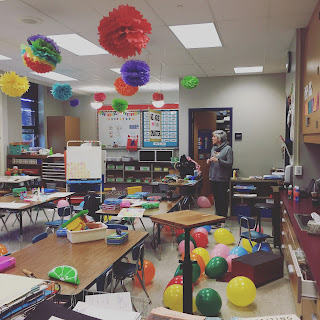Hello! If you're reading this blog post than you are interested in learning more about Morning Meetings. I consider these posts to be the cliff notes to the book
The Morning Meeting Book. It's 218 pages and since summer is short, it might make sense for me to read it and provide you with the gritty details here. It is a great book that I highly recommend so if you'd like to read it with me, consider these posts a book club. I'll be posting questions I have throughout the post that you can respond to in the comments (if you'd like...no pressure). I learn better by talking, or typing, about what I'm learning so I'd love to hear everyone's thoughts. OK. Here we go...the INTRODUCTION. It had a lot of information...I might not have to read the rest of the book....hahaha...just kidding.

So, let's start with a question WHY? Why should we invest time in starting each day with a morning meeting? Is it important enough to take the time to do it? Is this something just for K/1? Well....this book suggests morning meetings be implemented daily from Kindergarten all the way to Middle School/8th grade. Yeah. It will look different in every grade but the format (we'll get to the four components soon) will be the same. The morning meeting creates a foundation for every lesson we teach, every conflict we resolve, and every interaction our students have. It's important. It helps build that positive culture/community in our classroom that our principals are looking for during their observations. This is the backbone, folks!! The morning meeting creates a sense of belonging and helps practice the skills of attention, listening, expression and cooperation through interactions. The Morning Meeting is part of the Responsive Classroom. Have you heard of that? It was popular awhile back but is still relevant and is a research based program developed by the Northeast Foundation for Children. One of the seven basic tenets they subscribe to is that children need to learn a set of social skills in order to be successful. The skills are
cooperation,
assertion,
responsibility,
empathy and
self-control (CARES). So, I've already bought in...these are skills I want my students to develop and it's part of my report card. If we want children to be able to be knowledgable and responsible despite significant obstacles, then social and emotional skills and attitudes must be taught.

The introduction explains that it all starts with greeting kids at the door. You can learn a lot about kids if you see how they're feeling right at the start of school. Are they sleepy? Have they eaten? Are they excited for the day? Did they have a breakdown at home and got on the bus upset? As we greet students we learn a lot about them as (little) people and also model how important it is to notice and be noticed by each other as well.

The goal of the morning meeting is to begin each day as a community of caring and respectful learners. It starts by gathering in a circle. I'm thinking sit spots may help or in an older classroom having the desks form a circle. Then everyone greets each other. They listen and respond to each others' news. Topics of discussion might include: who is absent, what's the weather like, who is smiling or who is having a hard time smiling, problems that challenge our minds, what we have to look forward to with the school day's events. The morning meeting is designed to last up to a half hour. This is a snapshot...more on this in a later post.
There are four components to a morning meeting. Each component is designed to practice the skills of greeting, listening and responding, group problem solving, noticing and anticipating. The first component is
Greeting. During this time children greet each other by name often including handshaking, clapping, singing, etc. Then there is
Sharing. During this time students share news of interest and respond to each other. It's a time to articulate their thoughts, feelings and ideas in a positive manner. Next is a
Group Activity. The intro was pretty short about this and simply described it as a time to build class cohesion with a short activity. I'm ready to hear more about this. Finally there is the
Morning Message. The kids will warm up for the day by reading and discussing a daily message. This gives them a chance to practice some academic skills to get ready for the day.
A lot of us do these things every morning. It might not be in a circle or happen every day, but we all have our morning routines. I'm excited to see if by implementing these components in a systematic and dependable routine it helps my students better develop social and problem solving skills. Our goal is to get them ready for adulthood and be citizens in a society. Developing these skills can only help. :-)
If you're interested in purchasing
The Morning Meeting Book by Roxann Kriete, please click
here.
Discussion time!! Here are some things I was thinking about as I read. Please feel free to share your thoughts in the comments. I will respond no matter if you comment tomorrow or days/years/months from now. I love this stuff. Lol.
1. Do you already do a morning meeting? If so, what do you already include?
2. Morning message...what does this look like in your classroom? What have you found that works or does not work?
3. Sometimes I feel like sharing news takes FOREVER. Do you plan on allowing every student a chance to share every day or will you pick a few a day? How will you track this?
4. What do you think a morning meeting looks like in upper grades/middle school?
Please check back for the next post, MORNING MEETING: an overview. :-)


























































